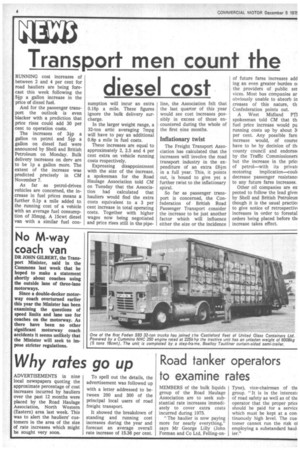Transport men count the diesel cost
Page 6

If you've noticed an error in this article please click here to report it so we can fix it.
RUNNING cost increases of between 2 and 4 per cent for road hauliers are being forecast this week following the 5ip a gallon increase in the price of diesel fuel.
And for the passenger transport the outlook •is even blacker with a prediction that price rises could add 30 per cent to operation costs.
The increases of hp a gallon on petrol and 5/p a gallon on diesel fuel were announced by Shell and British Petroleum on Monday. Bulk delivery increases on dery are to be lp a gallon more. The extent of the increase was predicted precisely in CM November 7.
As far as petrol-driven vehicles are concerned, the increase in fuel prices means a further 0.1p a mile added to the running cost of a vehicle with an average fuel consumption of 35mpg. A 15cwt diesel van with a similar fuel con sumption will incur an extra 0.16p a mile. These figures ignore the bulk delivery surcharge.
In the larger weight range, a 32-ton artic averaging 7mpg will have to pay an additional 0.8p a mile in fuel costs.
These increases are equal to approximately 2, 2.5 and 4 per cent extra on vehicle running costs respectively.
Expressing disappointment with the size of the 4ncrease, a spokesman for the Road Haulage Association told CM on Tuesday that the Association had calculated that hauliers would find the extra costs equivalent to a 3 per cent increase in total operating costs. Together with higher wages now being negotiated and price rises still in the pipe line, the Association felt that the last quarter of this year would see cost increases possibly in excess of those encountered during the whole of the first nine months.
Inflationary twist
The Freight Transport Association has calculated that the increases will involve the road transport industry in the expenditure of an extra E,BnI in a full year. This, it points out, is bound to give yet a further twist to the inflationary spiral.
So far as passenger transport is concerned, the Confederation of British Road Passenger Transport consider the increase to be just another factor which will influence either the size or the incidence of future fares increases add ing an even greater burden oi the providers of public ser vices. Most bus companies ar obviously unable to absorb in creases of this nature, th Confederation points out.
A West Midland PTI spokesman told CM that th, fuel price increase would pu running costs up by about 31 per cent. Any possible fare increase would, of coursE have to be by decision of th, county council and endorse( by the Traffic Commissioners but the increase in the prici of petrol—with its privat( motoring implication—coul( decrease passenger resistanci to any future fares increases.
Other oil companies are ex pected to follow the lead giver by Shell and British Petroleun though it is the usual practici to give notice of retrospectivt increases in order to forestal orders being placed before th( increase takes effect.


































































































































